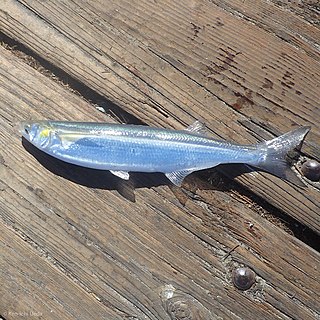| Bathylagoides | |
|---|---|
| Scientific classification | |
| Kingdom: | Animalia |
| Phylum: | Chordata |
| Class: | Actinopterygii |
| Order: | Argentiniformes |
| Family: | Bathylagidae |
| Genus: | Bathylagoides Whitley, 1951 |
Bathylagoides is a genus of deep-sea smelts.
| Bathylagoides | |
|---|---|
| Scientific classification | |
| Kingdom: | Animalia |
| Phylum: | Chordata |
| Class: | Actinopterygii |
| Order: | Argentiniformes |
| Family: | Bathylagidae |
| Genus: | Bathylagoides Whitley, 1951 |
Bathylagoides is a genus of deep-sea smelts.
Three recognized species are in this genus: [1]

Smelts are a family of small fish, the Osmeridae, found in the North Atlantic and North Pacific Oceans, as well as rivers, streams and lakes in Europe, North America and Northeast Asia. They are also known as freshwater smelts or typical smelts to distinguish them from the related Argentinidae, Bathylagidae, and Retropinnidae.

The Osmeriformes are an order of ray-finned fish that includes the true or freshwater smelts and allies, such as the galaxiids and noodlefishes; they are also collectively called osmeriforms. They belong to the teleost superorder Protacanthopterygii, which also includes pike and salmon, among others. The order's name means "smelt-shaped", from Osmerus + the standard fish order suffix "-formes". It ultimately derives from Ancient Greek osmé + Latin forma, the former in reference to the characteristic aroma of the flesh of Osmerus.

The delta smelt is an endangered slender-bodied smelt, about 5 to 7 cm long, in the family Osmeridae. Endemic to the upper Sacramento-San Joaquin Estuary of California, it mainly inhabits the freshwater-saltwater mixing zone of the estuary, except during its spawning season, when it migrates upstream to fresh water following winter "first flush" flow events. It functions as an indicator species for the overall health of the Delta's ecosystem.

Hypomesus is a genus of smelts (Osmeridae), consisting of five species found in the northern hemisphere.

Spirinchus is a genus of smelts (Osmeridae) from the North Pacific Ocean and adjacent streams.

Atherina is a genus of fish of silverside family Atherinidae, found in the temperate and tropic zones. Up to 15 cm long, they are widespread in the Mediterranean, Black Sea, Sea of Azov in lagoons and estuaries. It comes to the low stream of the Dnieper, Southern Bug, Dniester and Danube Rivers.

Osmerus is a genus of smelt.
Bathylagus is a genus of deep-sea smelts, some species of which are noted for having stylophthalmine larvae.

The goiter blacksmelt is a species of deep-sea smelt found in the North Atlantic Ocean. It is the biomass-dominant pelagic fish over the Mid-Atlantic Ridge when the entire water column is fully considered. The water-column in which it resides is 500 to 3,237 m deep. No topographic trapping can be performed on the species as they do not vertically migrate. This species grows to a length of 13 cm (5.1 in).

Leptochilichthys is a genus of marine smelts containing four species. Leptochilichthys is the only genus in the former family Leptochilichthyidae but is now included within the broader family Alepocephalidae.

Prototroctes is a genus of New Zealand smelts containing one species native to Australia and another, now extinct, species that was native to New Zealand.
Glossanodon is a genus of fishes in the family Argentinidae.
Dolicholagus longirostris, the longsnout blacksmelt, is a species of deep-sea smelt found circumglobally in deep waters of the tropics and subtropics. It is found at depths of 200 to 945 m. This species grows to a length of 17.5 cm (6.9 in).
Lipolagus ochotensis, the eared blacksmelt, is a species of deep-sea smelt found in the Pacific Ocean down to depths of 6,100 m (20,000 ft). This species grows to a length of 16 cm (6.3 in).
Pseudobathylagus milleri, the stout blacksmelt, also called the owlfish due to its large eyes relative to its body, is a species of deep-sea smelt native to the north Pacific Ocean where it is found to depths of 6,600 m (21,700 ft). This species grows to a length of 16.5 cm (6.5 in).

Retropinna is a genus in the family Retropinnidae containing one species that is widespread in southeastern Australia, one from Tasmania and one from New Zealand.

Lestidium is a genus of barracudina. They are sometimes referred to as pike smelt.

Atherinopsis californiensis, the jack silverside or jacksmelt, is a species of neotropical silverside native to the Pacific coast of North America from Oregon, United States to southern Baja California, Mexico. This species grows to 45 cm (18 in) in total length and is important commercially as a source of human food. It is the only known member of its genus. The adults occur in inshore areas, such as bays. They form schools. This species is a demersal spawners in inshore habitats, it is oviparous and the larvae are planktonic, living at the very surface of the water and feeding on phytoplankton. The eggs are attached to one another and to the substrate by adhesive filaments in the chorion.
The snubnose blacksmelt is a species of ray-finned fish in the deep-sea smelt family Bathylagidae. It is native to the northeastern Pacific Ocean.